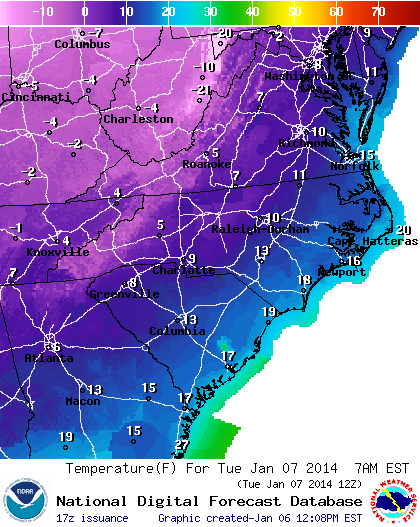Cold temperatures in the winter, such as we’re experiencing over the next couple-few days with a polar vortex can cause damage to plants, people, and livestock.  At this time of year, fruit buds on our main tree-fruit crops (apple, peach, cherry, and pear) are still in their winter dormant state (endodormancy). During endodormancy, buds have a very low water content and tend to be more cold tolerant. However, absolute lows are not the only factor to consider. If warm temperatures precede a cold spell, then tree buds tend to be less cold tolerant and are more likely to be damaged. There is also considerable variation amongst species and cultivars. For this reason, critical temperature thresholds, like those developed for spring frost damage to flower buds, are not well defined. However, from an ongoing discussion among pomologists in the Eastern part of North America, the consensus seems to be that peach flower buds start to be damaged at -10F and complete crop failure and/or tree loss occurs at -20F. Cherry and plum flower buds are slightly more cold hardy than peach buds and damage will likely occur at -20F. Apple flower buds can withstand temperatures down to -25F. As of now, the forecast for most of Virginia does not show temperatures dropping below 0F. Hopefully, this means that fruit buds in Virginia will not be damaged by the polar vortex.
At this time of year, fruit buds on our main tree-fruit crops (apple, peach, cherry, and pear) are still in their winter dormant state (endodormancy). During endodormancy, buds have a very low water content and tend to be more cold tolerant. However, absolute lows are not the only factor to consider. If warm temperatures precede a cold spell, then tree buds tend to be less cold tolerant and are more likely to be damaged. There is also considerable variation amongst species and cultivars. For this reason, critical temperature thresholds, like those developed for spring frost damage to flower buds, are not well defined. However, from an ongoing discussion among pomologists in the Eastern part of North America, the consensus seems to be that peach flower buds start to be damaged at -10F and complete crop failure and/or tree loss occurs at -20F. Cherry and plum flower buds are slightly more cold hardy than peach buds and damage will likely occur at -20F. Apple flower buds can withstand temperatures down to -25F. As of now, the forecast for most of Virginia does not show temperatures dropping below 0F. Hopefully, this means that fruit buds in Virginia will not be damaged by the polar vortex.
Plants are not affected by wind chills (plants do not lose heat to the wind). But people and animals will be impacted by the heat loss from the high winds that are accompanying this storm. I’ve seen several wind chill forecasts for Tuesday in the -10 to -20F range. If your pruning crews are outside, make sure they are dressed appropriately for the cold. Also, make sure that your farm animals at least have shelter from the wind. For more information on protecting farm animals and equipment from the cold, read Cory Childs’ (VCE-Warren Co.) blog post from earlier today.
